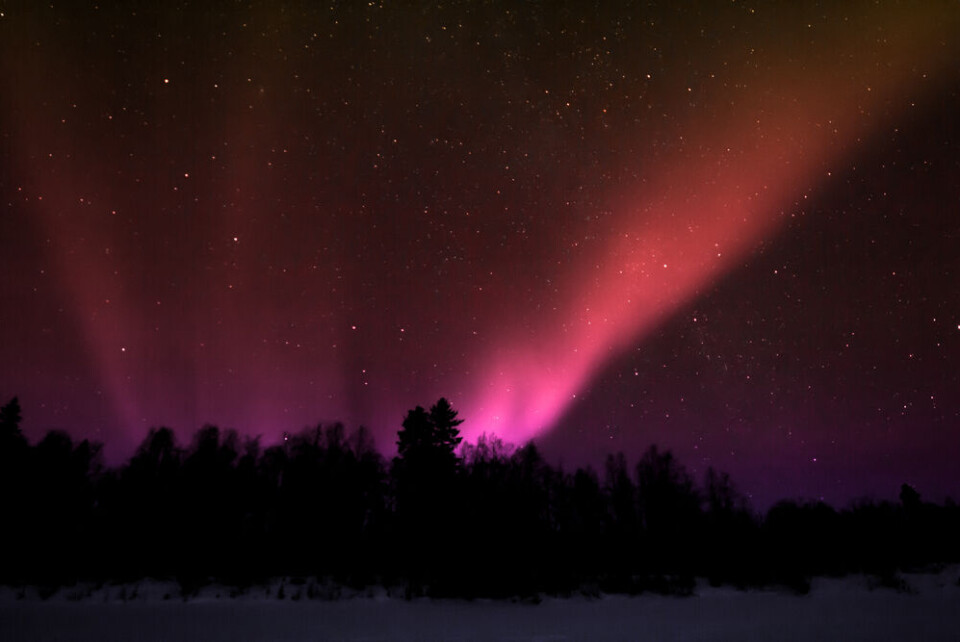-
How long does it take to sell property in different areas of France? New study
Many major cities are showing signs of recovery when it comes to supply, demand, prices, and time to sell
-
Map: Car insurance costs rise in France - see the average in your region
Multiple studies show that costs are rising by around 5% year-on-year, with major differences by region and vehicle model
-
Paris pledges action against voyeurs in public swimming pool changing rooms
It comes after several women came forward to report similar sexual assaults
PHOTOS: Northern Lights turn French skies pink and purple
The spectacle was seen in several areas - and not just in the north

The Northern Lights lit up several regions of France yesterday (November 5) evening, turning the skies shades of pink, purple and red.
The Aurora Borealis could be seen in Pas-de-Calais, the Alps, Auvergne, Alsace, but also on the French Riviera; many people shared their photos on social networks.
Aurore boréale au dessus de Fréjus vers 20h30, ce soir.
— Christophe Suarez (@suarezphoto) November 5, 2023
La lueur boréale était visible à l'oeil nu !
Photo 1 et 2.
Photo 3 : 2 minutes avant...#northernlights #AuroreBoreale #aurora #StormHour @KeraunosObs @PlanetarioMad #CotedAzurFrance #frejus pic.twitter.com/8lm2aZm18R
Nouvelle contribution d'une photo d'aurore boréale prise hier soir près de Trimbach (67) en #Alsace, prise par Mickaël SC. #AuroreBoreale pic.twitter.com/evSTYORG9b
— Suivi des orages en Alsace (@OragesAlsace) November 6, 2023
This light spectacle is generally only seen in more extreme latitudes, usually visible near the North and South Poles – the Southern lights being called the Aurora Australis.
To have any hope of seeing the Northern Lights, it is recommended to look at the sky in a northerly direction.
Caused by solar wind
The phenomenon was caused by a wave of solar particles that created a "geomagnetic storm", said scientific mediator Pierre Henriquet on social media platform X (previously Twitter).
Pour celles et ceux qui sont encore réveilles, sortez et regardez du côté du Nord.
— Astropierre (@astropierre) November 5, 2023
L'arrivée cette nuit d'une vague de particules solaire provoque en ce moment même (dimanche soir) une tempête géomagnétique et la formation d'une aurore boréale visible depuis la France. https://t.co/iC4G7IjJLw
The Aurora Borealis appears when streams of hot, charged particles, known as ‘solar wind’ reach Earth's environment.
The particles meet gases in our atmosphere and depending where they are, different amounts of energy are released as different wavelengths of light – oxygen produces green light, while nitrogen causes the sky to glow red.
The colours in France are warmer because of the country’s lower altitude.
2 clichés des aurores boréales de ce soir, ici au nord de Clermont-Ferrand.
— Alexis Linant 🧙 (@AlexisLinant63) November 5, 2023
Un rêve.#aurore #Auroraborealis #auroresboreales #Auvergne pic.twitter.com/JgflTyR52R
A rare sight in France
In lower altitudes, such as in France, the Aurora Borealis are rare and usually can only be seen every ten or 20 years with the right conditions.
However, France had already seen the northern lights twice already this year, in February and in August.
This means there is still a chance to see them again in 2023, however at the moment there is no information on when this may be.
The lights were also observed in a number of other European countries including the Ukraine, Belgium, the Netherlands, Germany and the United Kingdom where magnificent colours were seen above Stonehenge.
Northern Lights over Stonehenge last night 😍✨#aurora #auroraborealis #northernlights #stonehenge
— Stonehenge U.K (@ST0NEHENGE) November 5, 2023
Photo credit Stonehenge Dronescapes on FB 👏👏👏 pic.twitter.com/aFh2XWOME5
🛰️ En lien avec une nouvelle tempête solaire, de nouvelles #auroresboréales ont été observées ce dimanche soir dans le ciel de Côte d'Or, plus exactement à #Tanay ( nord-est de Dijon ) 🌈😍
— Météo Côte-d'Or (@OrMeteo) November 5, 2023
📸 Par Nicolas Drouhin pic.twitter.com/X7CYWzAhip
The history of Aurora Borealis
It was the Italian astronomer Galielo Galiliei who chose the name Aurora Borealis in 1619, after the roman goddess of dawn, Aurora, and the Greek god of the north wind, Boreas.
However, the earliest record of the Northern Lights is believed to be earlier than this.
In southwestern France, prehistoric Cro-Magnon cave paintings were discovered and among these was what may be the earliest depiction of the Aurora.
An old and simple form of art created by clay finger tracing, it is believed to be 30,000-years-old.
Aurore boréale au dessus du Mont Saint-Michel de Brasparts (Finistère) dans la nuit du 05 au 06 Novembre 2023.
— Mathieu Rivrin - Photographies (@mathieurivrin) November 6, 2023
Mathieu Rivrin#aurore #auroreboreale #france pic.twitter.com/aKaTcC4nSW
Read also
Photographer captures rare red sprite lightning near Dordogne chateau
Watch: ‘Shooting star’ meteor lights up Paris and Rouen skies
























